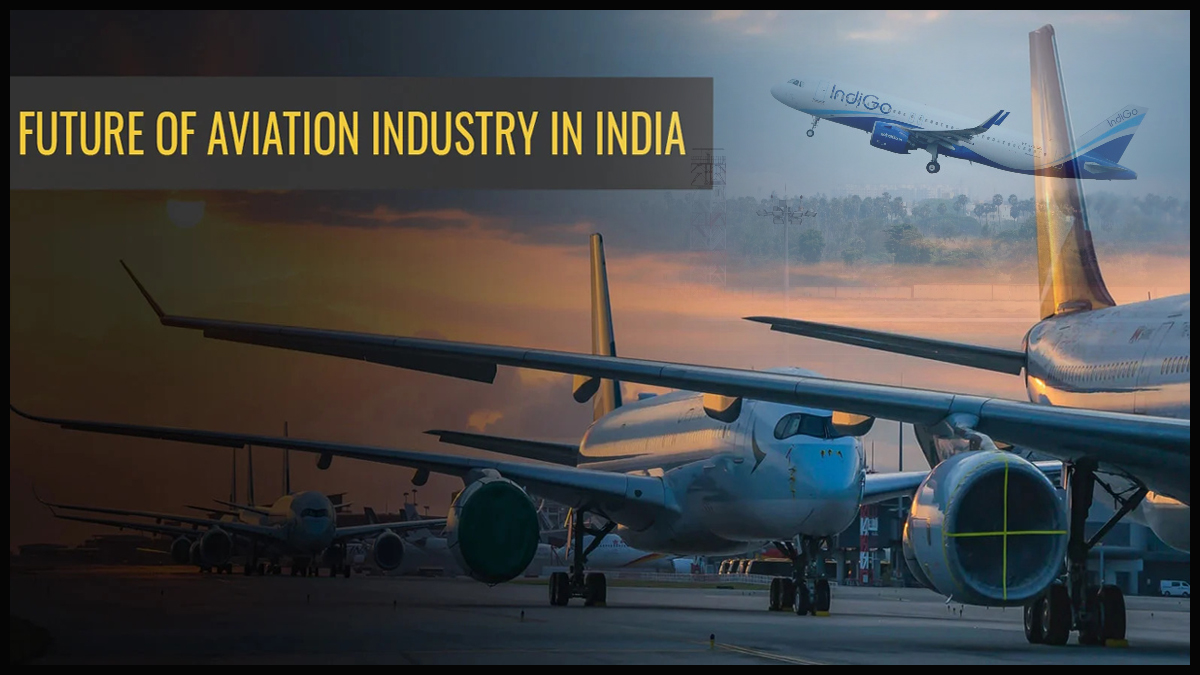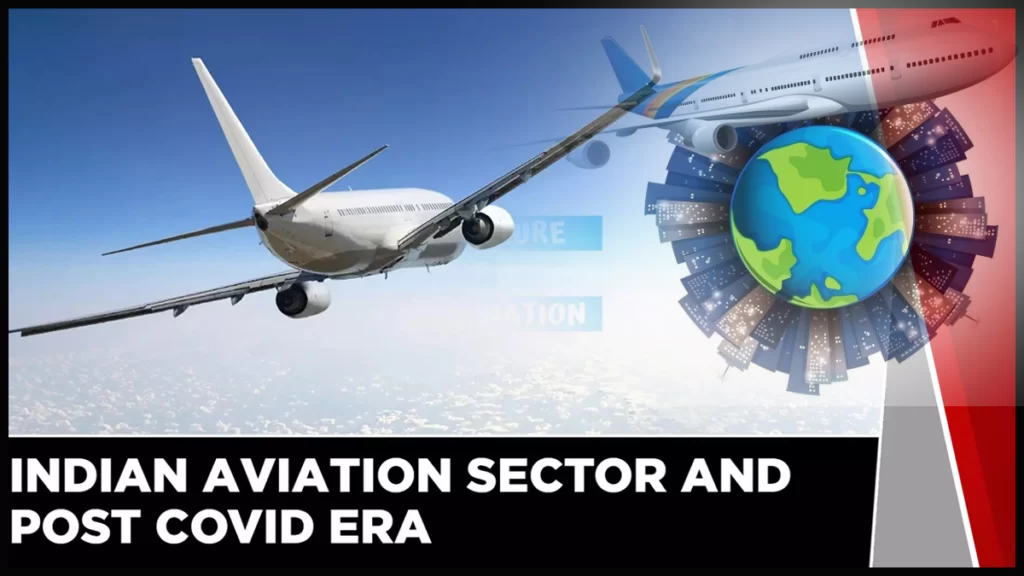
The Indian aviation industry has seen a significant growth over the past few years, with a large number of people choosing air travel for domestic as well as international destinations. Here’s a rundown of the Indian aviation industry:
Market size: The Indian aviation industry is the third-largest domestic aviation market in the world, with a market size of over USD 16 billion.
Key players: The major players in the Indian aviation industry are IndiGo, SpiceJet, Vistara, Air India, and GoAir.
Fleet size: The total number of aircraft in India is around 700, with IndiGo having the largest fleet size of 250+ aircraft.

Domestic connectivity: The Indian aviation industry is well-connected domestically, with over 130 airports across the country.
International connectivity: India has over 40 international airports and is well-connected to major international destinations such as Dubai, Singapore, London, and New York.
Growth potential: The Indian aviation industry has immense growth potential, with a growing middle class and an increase in air travel demand. It is projected that by 2040, India will be the third-largest aviation market in the world.
Challenges: Despite the growth potential, the Indian aviation industry faces several challenges such as high operating costs, lack of infrastructure, and intense competition. Additionally, the COVID-19 pandemic has impacted the industry, leading to a decline in air travel demand and financial losses for airlines.
Overall, the Indian aviation industry is a crucial component of the country’s economy and has a promising future. However, the industry needs to address its challenges to sustain growth and remain competitive in the global market.
Here are some additional details about the Indian aviation industry:
Regulatory body: The regulatory body for the Indian aviation industry is the Directorate General of Civil Aviation (DGCA), which is responsible for regulating and overseeing the safety and security aspects of civil aviation.
Aviation hubs: India has several aviation hubs, with the major ones being Delhi, Mumbai, Bangalore, Hyderabad, Chennai, and Kolkata. These airports serve as major gateways for both domestic and international travel.
Low-cost carriers: The Indian aviation industry is dominated by low-cost carriers (LCCs) such as IndiGo and SpiceJet. LCCs have played a significant role in democratizing air travel in India by offering affordable fares and expanding air connectivity to smaller cities.
Infrastructure development: The Indian government has taken several steps to develop aviation infrastructure in the country, such as the construction of new airports, modernization of existing ones, and the implementation of the Regional Connectivity Scheme (RCS) to enhance air connectivity to remote and underserved areas.
Industry associations: The Indian aviation industry has several industry associations such as the Federation of Indian Airlines (FIA), which represents the interests of airlines, and the Airports Authority of India (AAI), which manages and operates airports in the country.
Technological advancements: The Indian aviation industry has embraced technological advancements such as digital check-ins, e-boarding passes, and self-baggage drops to enhance the passenger experience and streamline airport operations.
Future outlook: The Indian aviation industry is expected to grow at a compound annual growth rate (CAGR) of 13.5% between 2021 and 2026, driven by factors such as rising disposable incomes, increasing urbanization, and government initiatives to boost air connectivity. However, the industry also faces challenges such as rising fuel prices, geopolitical risks, and environmental concerns.
How big is the aviation industry in India?
The Indian aviation industry is one of the largest in the world, with a market size of over USD 16 billion. It is the third-largest domestic aviation market globally and is expected to become the third-largest aviation market in the world by 2040. The industry contributes significantly to the Indian economy, with an estimated 7.5 million jobs directly or indirectly linked to it.
The aviation sector in India has witnessed tremendous growth over the past decade, with passenger traffic increasing from 61 million in 2010 to over 340 million in 2019. The industry has been impacted by the COVID-19 pandemic, leading to a decline in air travel demand and financial losses for airlines.
However, the Indian aviation industry is expected to recover in the post-pandemic era. Also driven by factors such as increasing air travel demand, rising disposable incomes, and government initiatives to boost air connectivity.
What is the current status of the aviation industry in India?
The aviation industry in India has been impacted by the COVID-19 pandemic. Also leading to a decline in air travel demand and financial losses for airlines. The Indian government imposed a nationwide lockdown in March 2020, which severely impacted the aviation industry.
The passenger traffic in the Indian aviation industry decreased by 56.6% in 2020 compared to the previous year. However, the Indian aviation industry has shown signs of recovery in recent months as the government has eased travel restrictions. And vaccination drives have been initiated.
According to the Directorate General of Civil Aviation (DGCA)
According to the Directorate General of Civil Aviation (DGCA). Domestic passenger traffic in India increased by 27.1% in January 2022 compared to the previous year. And international passenger traffic increased by 16.6% in the same period.
However, the passenger traffic is still below pre-pandemic levels. The Indian aviation industry is expected to recover gradually in the post-pandemic era. Also driven by factors such as increasing air travel demand, rising disposable incomes, and government initiatives to boost air connectivity.
The major players in the Indian aviation industry have taken several measures to reduce costs. And improve efficiency, such as renegotiating lease agreements. Also reducing employee salaries, and optimizing routes.
The Indian government has also taken several steps to support the Aviation industry. And such as Providing financial aid to Airlines and Reducing taxes on Aviation fuel. The future outlook for the Indian Aviation industry is positive. And with the industry Projected to grow at a Compound annual growth rate (CAGR) of 13.5% between 2021 and 2026.
Is the Aviation industry growing in India?
Yes, the Aviation industry in India has been growing rapidly over the past decade. And it is expected to continue growing in the Post-pandemic era. Despite the impact of the COVID-19 Pandemic, the Indian Aviation industry has shown Resilience and has started to recover Gradually.
The Indian Aviation industry has Witnessed significant growth in recent years. Also driven by factors such as Increasing Disposable incomes, Expanding Middle-class population. And government Initiatives to boost air Connectivity, and the Emergence of Low-cost Carriers (LCCs). According to the Ministry of Civil Aviation, the number of Domestic. And international passengers in India grew at a Compound annual growth rate (CAGR) of 11.5% between 2010 and 2019.
In the future, the Indian Aviation industry is expected to grow at a CAGR of 13.5% between 2021 and 2026. And driven by factors such as Increasing air travel demand, rising Disposable incomes, and government Initiatives to boost air Connectivity.
The Indian government has taken several steps to support the Aviation industry. And such as Providing financial aid to Airlines and Reducing taxes on Aviation fuel. The industry has also Witnessed Technological Advancements such as digital Check-ins. E-boarding passes, and Self-baggage drops, which have Enhanced the Passenger experience and Streamlined airport operations.
Who is the father of Aviation?
The father of Aviation is Generally considered to be Orville Wright (1871-1948) and his brother Wilbur Wright (1867-1912). Who are Credited with Inventing and building the world’s first successful Airplane. In 1903, the Wright brothers made the first powered, controlled. And Sustained flight in a Heavier-than-air machine in Kitty Hawk, North Carolina. Their achievement Revolutionized Transportation and had a Profound impact on the world, making air travel and Aviation industry possible.
Also Read – The Wolf of Wall Street Movie
What are the four pillars of Aviation?
The four pillars of Aviation are the four key areas that are Essential for the success and Sustainability of the Aviation industry. They are:
- Safety: Safety is the top priority in Aviation. And it is crucial to maintain the highest standards of safety in all aspects of Aviation operations. This includes aircraft design and Maintenance, air traffic control, and pilot training, among others.
- Security: Security is critical to protect passengers, crew, and aircraft from acts of Unlawful Interference, such as Terrorism or Sabotage. Aviation security includes measures such as Screening passengers and their baggage. Also Securing the airport Perimeter, and Conducting background checks on Aviation personnel.
- Sustainability: The Aviation industry must take steps to reduce its Environmental impact and promote Sustainable practices. This includes Reducing Greenhouse Gas Emissions, Minimizing noise Pollution, and Conserving natural resources.
- Efficiency: Efficiency is Essential for the Economic Viability of the Aviation industry. This includes Optimizing aircraft design and operations, Improving air traffic management, and Reducing delays and Congestion at airports. Efficient operations help to reduce costs, improve customer Satisfaction, and enhance the Competitiveness of the Aviation industry.
Also Read – All about Los Angeles Police Department
What is the full meaning of Aviation?
The term “Aviation” refers to the operation and management of aircraft. Also including the design, development, production, testing, and operation of aircraft. The word “Aviation” is derived from the Latin word “avis,” which means bird.
The full meaning of Aviation is the activities Surrounding the development, production. And operation of aircraft and the Associated Technologies, including air Transportation, air traffic control. Aircraft Maintenance, and Aviation safety and security.
Also Read – Antibiotics for seasonal cold and cough

One thought on “All about Indian Aviation Industry”